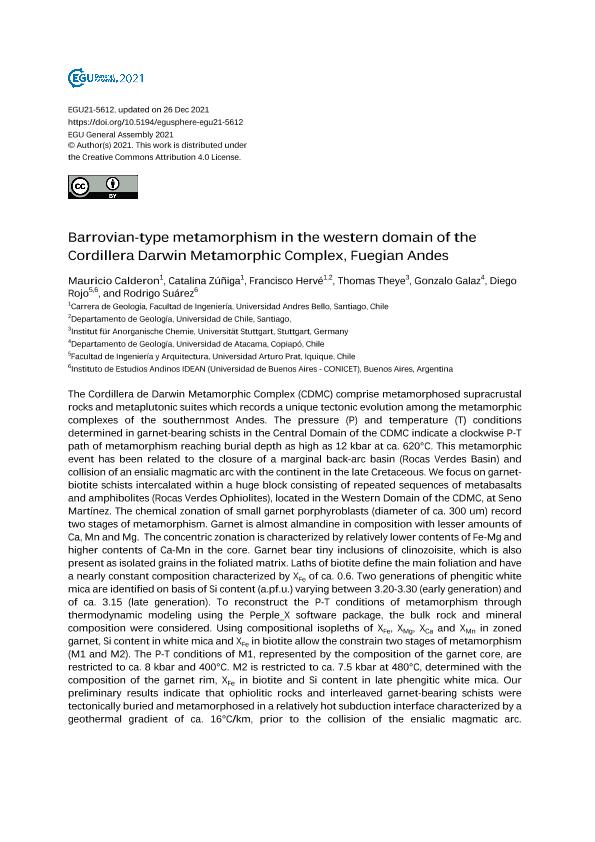Evento
Barrovian-type metamorphism in the western domain of the Cordillera Darwin Metamorphic Complex, Fuegian Andes
Calderón, Mauricio; Zuñiga, Catalina; Hervé, Francisco; Theye, Thomas; Galaz, Gonzalo; Rojo, Diego; Suárez, Rodrigo Javier

Tipo del evento:
Congreso
Nombre del evento:
EGU General Assembly 2021
Fecha del evento:
19/04/2021
Institución Organizadora:
European Geosciences Union;
Título de la revista:
Geophysical Research Abstracts
Editorial:
Copernicus Publications
Idioma:
Inglés
Clasificación temática:
Resumen
The Cordillera de Darwin Metamorphic Complex (CDMC) comprise metamorphosed supracrustal rocks and metaplutonic suites which records a unique tectonic evolution among the metamorphic complexes of the southernmost Andes. The pressure (P) and temperature (T) conditions determined in garnet-bearing schists in the Central Domain of the CDMC indicate a clockwise P-T path of metamorphism reaching burial depth as high as 12 kbar at ca. 620°C. This metamorphic event has been related to the closure of a marginal back-arc basin (Rocas Verdes Basin) and collision of an ensialic magmatic arc with the continent in the late Cretaceous. We focus on garnet-biotite schists intercalated within a huge block consisting of repeated sequences of metabasalts and amphibolites (Rocas Verdes Ophiolites), located in the Western Domain of the CDMC, at Seno Martínez. The chemical zonation of small garnet porphyroblasts (diameter of ca. 300 um) record two stages of metamorphism. Garnet is almost almandine in composition with lesser amounts of Ca, Mn and Mg. The concentric zonation is characterized by relatively lower contents of Fe-Mg and higher contents of Ca-Mn in the core. Garnet bear tiny inclusions of clinozoisite, which is also present as isolated grains in the foliated matrix. Laths of biotite define the main foliation and have a nearly constant composition characterized by XFe of ca. 0.6. Two generations of phengitic white mica are identified on basis of Si content (a.pf.u.) varying between 3.20-3.30 (early generation) and of ca. 3.15 (late generation). To reconstruct the P-T conditions of metamorphism through thermodynamic modeling using the Perple_X software package, the bulk rock and mineral composition were considered. Using compositional isopleths of XFe, XMg, XCa and XMn in zoned garnet, Si content in white mica and XFe in biotite allow the constrain two stages of metamorphism (M1 and M2). The P-T conditions of M1, represented by the composition of the garnet core, are restricted to ca. 8 kbar and 400°C. M2 is restricted to ca. 7.5 kbar at 480°C, determined with the composition of the garnet rim, XFe in biotite and Si content in late phengitic white mica. Our preliminary results indicate that ophiolitic rocks and interleaved garnet-bearing schists were tectonically buried and metamorphosed in a relatively hot subduction interface characterized by a geothermal gradient of ca. 16°C/km, prior to the collision of the ensialic magmatic arc.
Archivos asociados
Licencia
Identificadores
Colecciones
Eventos(IDEAN)
Eventos de INSTITUTO DE ESTUDIOS ANDINOS "DON PABLO GROEBER"
Eventos de INSTITUTO DE ESTUDIOS ANDINOS "DON PABLO GROEBER"
Citación
Barrovian-type metamorphism in the western domain of the Cordillera Darwin Metamorphic Complex, Fuegian Andes; EGU General Assembly 2021; Alemania; 2021; 1-2
Compartir
Altmétricas



